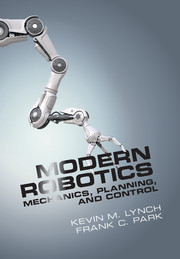Book contents
- Frontmatter
- Contents
- Foreword by Roger Brockett
- Foreword by Matthew Mason
- Preface
- 1 Preview
- 2 Configuration Space
- 3 Rigid-Body Motions
- 4 Forward Kinematics
- 5 Velocity Kinematics and Statics
- 6 Inverse Kinematics
- 7 Kinematics of Closed Chains
- 8 Dynamics of Open Chains
- 9 Trajectory Generation
- 10 Motion Planning
- 11 Robot Control
- 12 Grasping and Manipulation
- 13 Wheeled Mobile Robots
- A Summary of Useful Formulas
- B Other Representations of Rotations
- C Denavit–Hartenberg Parameters
- D Optimization and Lagrange Multipliers
- Bibliography
- Index
13 - Wheeled Mobile Robots
Published online by Cambridge University Press: 04 June 2024
- Frontmatter
- Contents
- Foreword by Roger Brockett
- Foreword by Matthew Mason
- Preface
- 1 Preview
- 2 Configuration Space
- 3 Rigid-Body Motions
- 4 Forward Kinematics
- 5 Velocity Kinematics and Statics
- 6 Inverse Kinematics
- 7 Kinematics of Closed Chains
- 8 Dynamics of Open Chains
- 9 Trajectory Generation
- 10 Motion Planning
- 11 Robot Control
- 12 Grasping and Manipulation
- 13 Wheeled Mobile Robots
- A Summary of Useful Formulas
- B Other Representations of Rotations
- C Denavit–Hartenberg Parameters
- D Optimization and Lagrange Multipliers
- Bibliography
- Index
Summary
A kinematic model of a mobile robot governs how wheel speeds map to robot velocities, while a dynamic model governs how wheel torques map to robot accelerations. In this chapter, we ignore the dynamics and focus on the kinematics. We also assume that the robots roll on hard, flat, horizontal ground without skidding (i.e., tanks and skid-steered vehicles are excluded). The mobile robot is assumed to have a single rigid-body chassis (not articulated like a tractor-trailer) with a configuration Tsb ϵ SE(2) representing a chassis-fixed frame ﹛b﹜ relative to a fixed space frame ﹛s﹜ in the horizontal plane. We represent Tsb by the three coordinates q = (ϕ, x, y). We also usually represent the velocity of the chassis as the time derivative of the coordinates, ˙ q = (˙ϕ, x˙ , y˙). Occasionally it will be convenient to refer to the chassis’ planar twist Vb = (ωbz, vbx, vby) expressed in ﹛b﹜, where
This chapter covers kinematic modeling, motion planning, and feedback control for wheeled mobile robots, and concludes with a brief introduction to mobile manipulation, which is the problem of controlling the end-effector motion of a robot arm mounted on a mobile platform.
Types of Wheeled Mobile Robots
Wheeled mobile robots may be classified in two major categories, omnidirectional and nonholonomic. Omnidirectional mobile robots have no equality constraints on the chassis velocity ˙ q = (˙ϕ, x˙ , y˙), while nonholonomic robots are subject to a single Pfaffian velocity constraint A(q)q˙ = 0 (see Section 2.4 for an introduction to Pfaffian constraints). For a car-like robot, this constraint prevents the car from moving directly sideways. Despite this velocity constraint, the car can reach any (ϕ, x, y) configuration in an obstacle-free plane. In other words, the velocity constraint cannot be integrated to an equivalent configuration constraint, and therefore it is a nonholonomic constraint.
Whether a wheeled mobile robot is omnidirectional or nonholonomic depends in part on the type of wheels it employs (Figure 13.1). Nonholonomic mobile robots employ conventional wheels, such as you might find on your car: the wheel rotates about an axle perpendicular to the plane of the wheel at the wheel's center, and optionally it can be steered by spinning the wheel about an axis perpendicular to the ground at the contact point.
Information
- Type
- Chapter
- Information
- Modern RoboticsMechanics, Planning, and Control, pp. 445 - 489Publisher: Cambridge University PressPrint publication year: 2017
